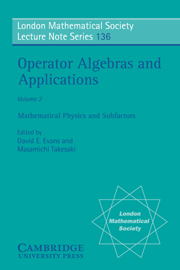Book contents
- Frontmatter
- Preface
- Contents
- UK-US Joint Seminar on Operator Algebras Lectures
- Some recent results for the planar Ising model
- The heat semigroup, derivations and Reynolds' identity
- C*-algebras in solid state physics: 2D electrons in uniform magnetic field
- Spin groups, infinite dimensional Clifford algebras and applications
- Subfactors and related topics
- Quantized groups, string algebras, and Galois theory for algebras
- On amenability in type II1 factors
- An index for semigroups of*-endomorphisms ofB(H)
- Coactions and Yang-Baxter equations for ergodic actions and subfactors
- Derived link invariants and subfactors
Some recent results for the planar Ising model
Published online by Cambridge University Press: 16 March 2010
- Frontmatter
- Preface
- Contents
- UK-US Joint Seminar on Operator Algebras Lectures
- Some recent results for the planar Ising model
- The heat semigroup, derivations and Reynolds' identity
- C*-algebras in solid state physics: 2D electrons in uniform magnetic field
- Spin groups, infinite dimensional Clifford algebras and applications
- Subfactors and related topics
- Quantized groups, string algebras, and Galois theory for algebras
- On amenability in type II1 factors
- An index for semigroups of*-endomorphisms ofB(H)
- Coactions and Yang-Baxter equations for ergodic actions and subfactors
- Derived link invariants and subfactors
Summary
Introduction
The planar Ising model has become one of the most important statistical mechanical systems for the study of phase transitions and critical phenomena. Although there are many rigorous results, such as correlation inequalities, Peierls argument and the Yang-Lee circle theorem to name but three [reviewed by Griffiths, 1971], which are dimensionindependent in their validity and which lead to results of considerable interest, only the planar model to date benefits from the added insights which stem ultimately from Onsager's tour de force [Onsager, 1944]. It is not the purpose of this article to enter into a general review – for this the reader is referred elsewhere [Gallavotti, 1972] but rather to discuss two more mathematical aspects of the development of Onsager's solution. The first item is the Yang-Baxter system of equations for the planar Ising model in zero field with transfer in the (1,1) direction. This work shows that the Clifford-algebraic structure of the exact solution is a natural consequence of the star-triangle equations. The second item is a Fredholm system which turns out to be of crucial importance in understanding surface and interface problems, as well as the pair correlation function.
- Type
- Chapter
- Information
- Operator Algebras and Applications , pp. 1 - 22Publisher: Cambridge University PressPrint publication year: 1989



